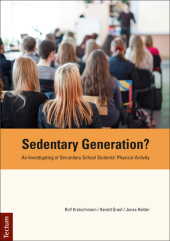 Neuerscheinungen 2016Stand: 2020-02-01 |
Schnellsuche
ISBN/Stichwort/Autor
|
Herderstraße 10
10625 Berlin
Tel.: 030 315 714 16
Fax 030 315 714 14
info@buchspektrum.de |

Harald Graef, Jonas Holder, Rolf Kretschmann
(Beteiligte)
Sedentary Generation?
An Investigating of Secondary School Students´ Physical Activity
2016. 165 S. m. zahlr. Tab. u. Diagr. 21 cm
Verlag/Jahr: TECTUM-VERLAG 2016
ISBN: 3-8288-3773-5 (3828837735)
Neue ISBN: 978-3-8288-3773-7 (9783828837737)
Preis und Lieferzeit: Bitte klicken
Today´s children and adolescents exposure to adequate levels of physical activity constantly headlines current academic discussion and debate when considering health and social status. Our younger generation is said to be in danger of becoming a sedentary generation due to media exposure and an inactive lifestyle. A closer look at youth´s behavioral settings reveals school being a major location where school-aged children and adolescents spend most of their available daytime. This inherent potential of everyday school to serve as a significant contributor to today´s youth´s physical activity motivates the main objectives of this investigation. Hence, this study focuses on physical activity levels of school students during the regular school day, including their way to school, recess, leisure, and regular classes as well as physical education.
1. Introduction
2. Key Terms and Concepts
2.1. Physical Activity
2.2. MET
2.3. Energy Expenditure
2.4. Counts
3. Literature Review
3.1. Significance of Physical Activity
3.1.1. Physical Activity and Health
3.1.1.1. Obesity
3.1.1.2. CVD
3.1.1.3. Type 2 Diabetes
3.1.1.4. Bone Health
3.1.1.5. Mental Health
3.1.1.6. Cancer
3.1.2. Physical Activity Levels and Recommendations
3.1.3. Physical Activity and Child Development
3.2. Physical Activity in Schools
3.2.1. Role of Physical Activity in School
3.2.2. Components of School-Related Physical Activity
3.2.2.1. Physical Education
3.2.2.2. Active Transportation
3.2.2.3. Recess
3.3. Significance of Physical Education
3.3.1. Legitimization of Physical Education
3.3.2. Quality in Physical Education
3.3.3. Physical Activity Levels in Physical Education
3.4. Measurement of Physical Activity
3.4.1. Observation
3.4.2. Self-Report Methods
3.4.2.1. Physical Activity Questionnaire
3.4.2.2. Activity Diary/Log
3.4.3. Objective Methods
3.4.3.1. Accelerometry and Pedometry
3.4.3.2. Heart Rate Monitoring
3.4.3.3. Combined Heart Rate Monitoring and Accelerometry
3.4.3.4. Other Methods
4. Study I: School Day
4.1. Hypotheses
4.2. Methods
4.2.1. Instruments
4.2.1.1. Actiheart Sensor
4.2.1.2. Questionnaire
4.2.1.3. Physical Activity Diary
4.2.2. Variables
4.2.3. Study Protocol
4.2.4. Sample
4.2.5. Data
4.3. Results
4.3.1. School Way
4.3.2. Recess Time
4.3.3. Days with Physical Education
4.3.4. School and Leisure Time
4.3.5. Weekend and Weekday
4.3.6. International Recommendations
4.4. Discussion
4.4.1. School Way
4.4.2. Recess Time
4.4.3. Physical Education
4.4.4. School Time and Leisure Time
4.4.5. Weekends and Weekdays
4.4.6. International Recommendations
4.4.7. Limitations
5. Study II: Physical Education
5.1. Hypotheses
5.2. Methods
5.2.1. Participants and Setting
5.2.2. Instruments and Procedures
5.2.3. Data Analysis
5.3. Results
5.3.1. Recommendations
5.3.2. Gender
5.3.3. Grade Level
5.3.4. Time of Day
5.3.5. PE Area
5.3.6. Weight
5.3.7. Warm-Up
5.4. Discussion
5.4.1. Physical Activity Guidelines
5.4.2. Gender
5.4.3. Time of Day
5.4.4. PE Area
5.4.5. Weight
5.4.6. Warm-Up
6. Conclusive Remarks
6.1. Study I: School Day
6.2. Study II: Physical Education
7. References
8. Appendix
8.1. Parental Declaration of Consent
8.2. Student Questionnaire
8.3. Student Activity Diary
9. Author Information


